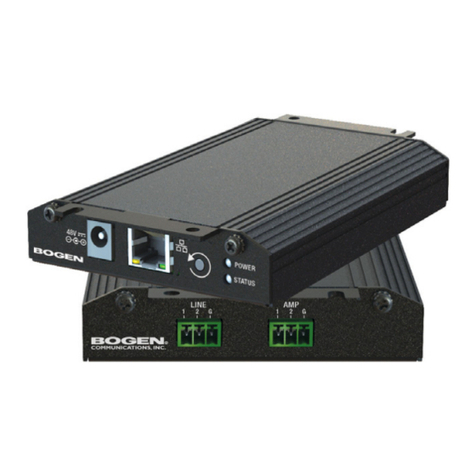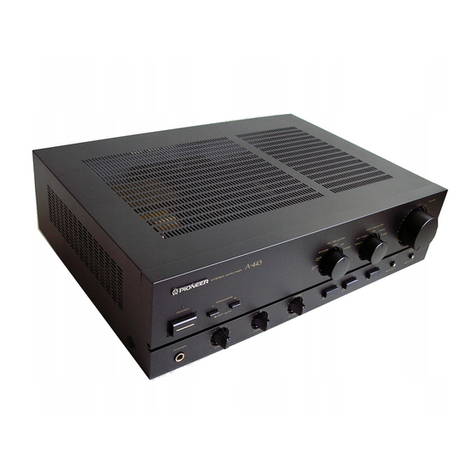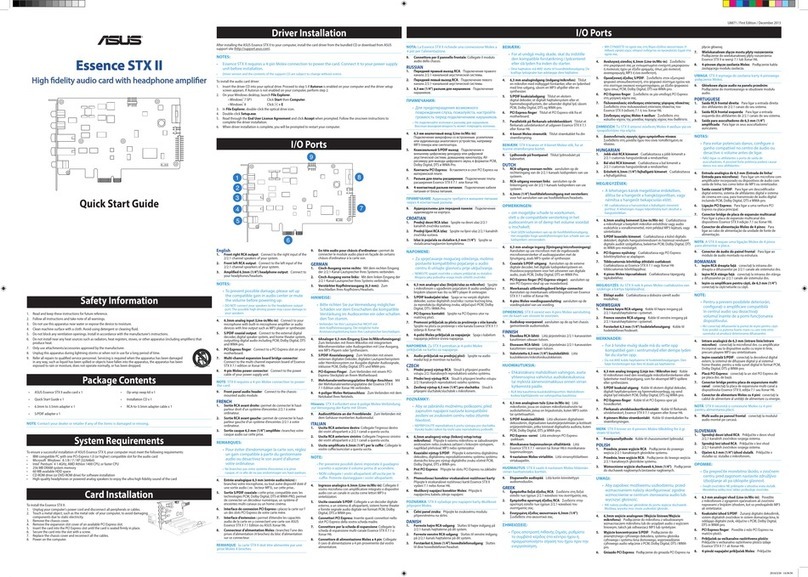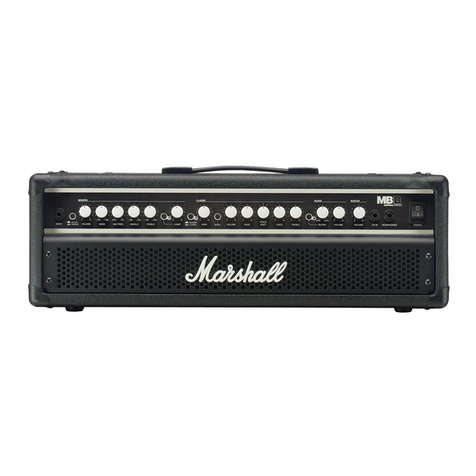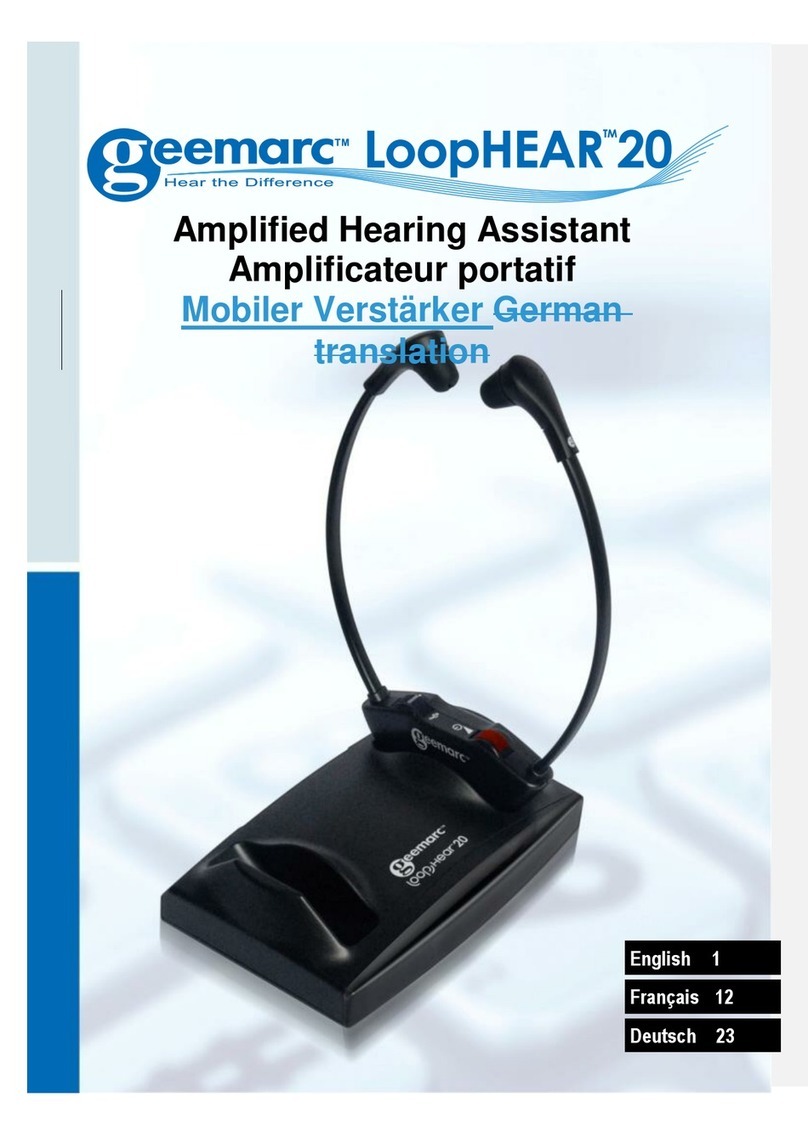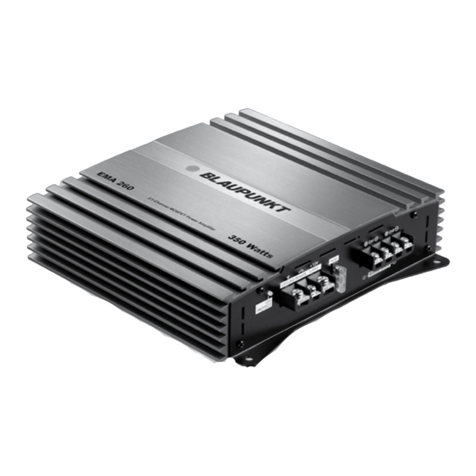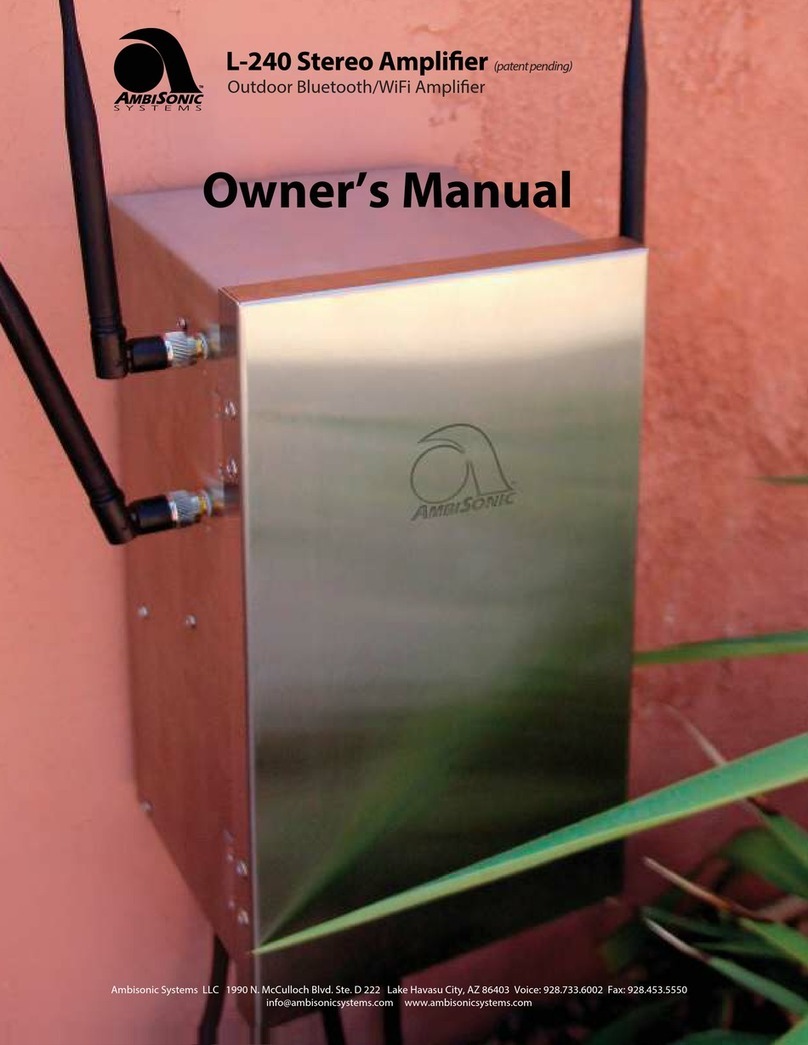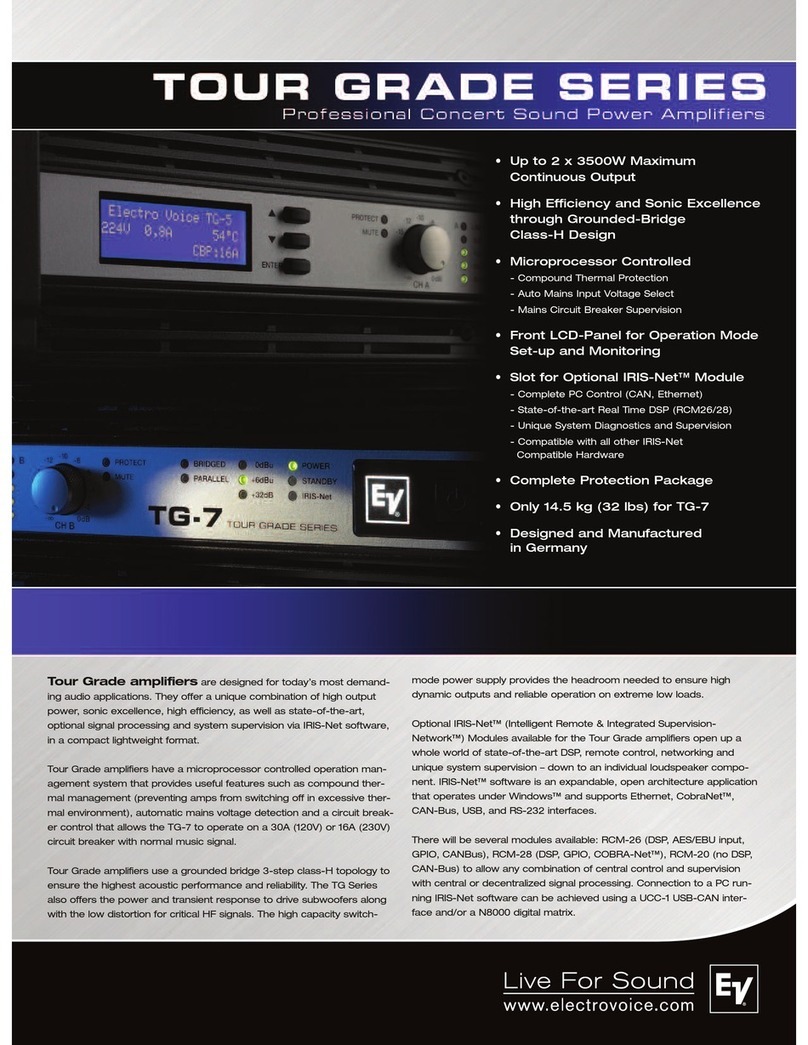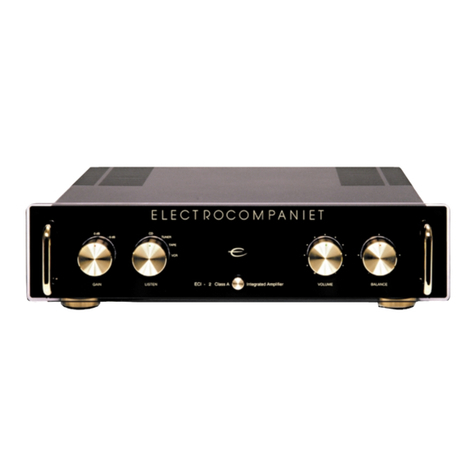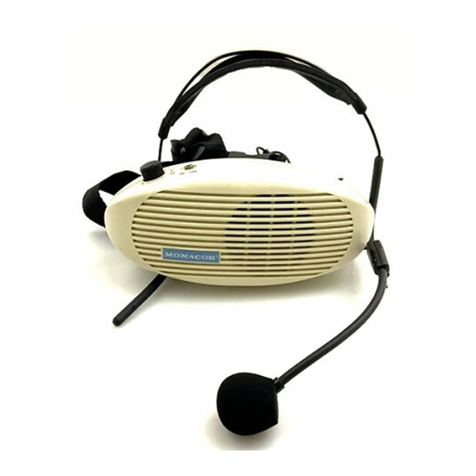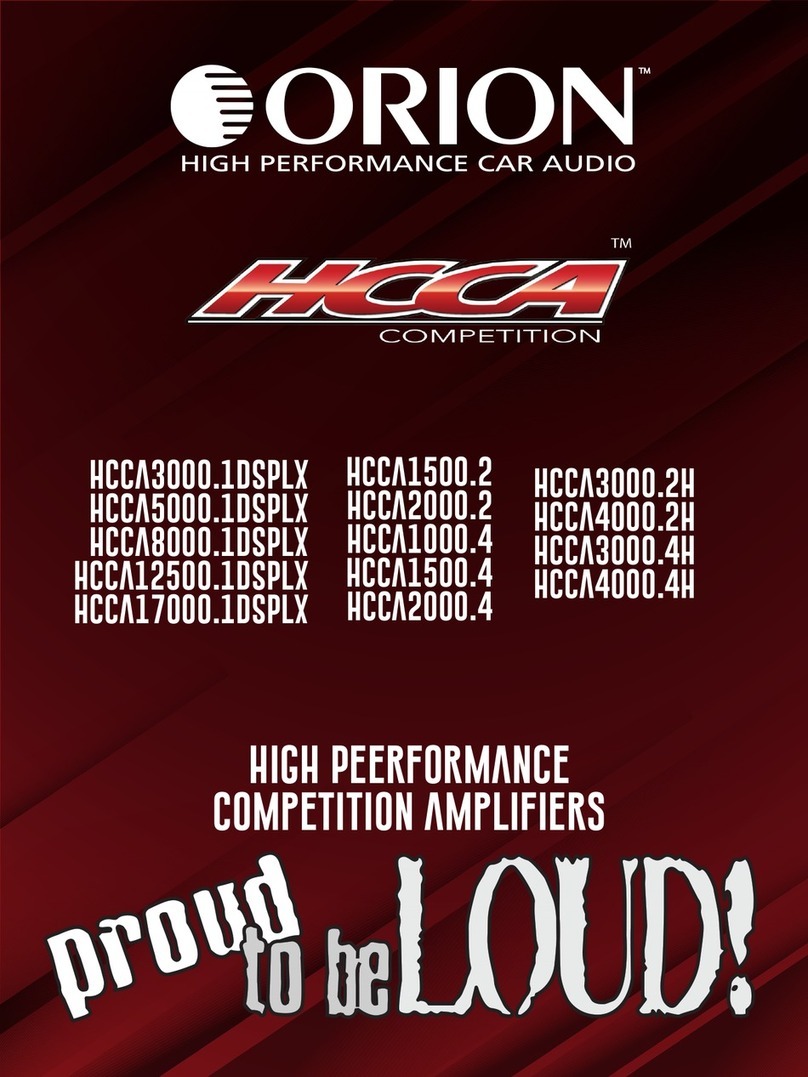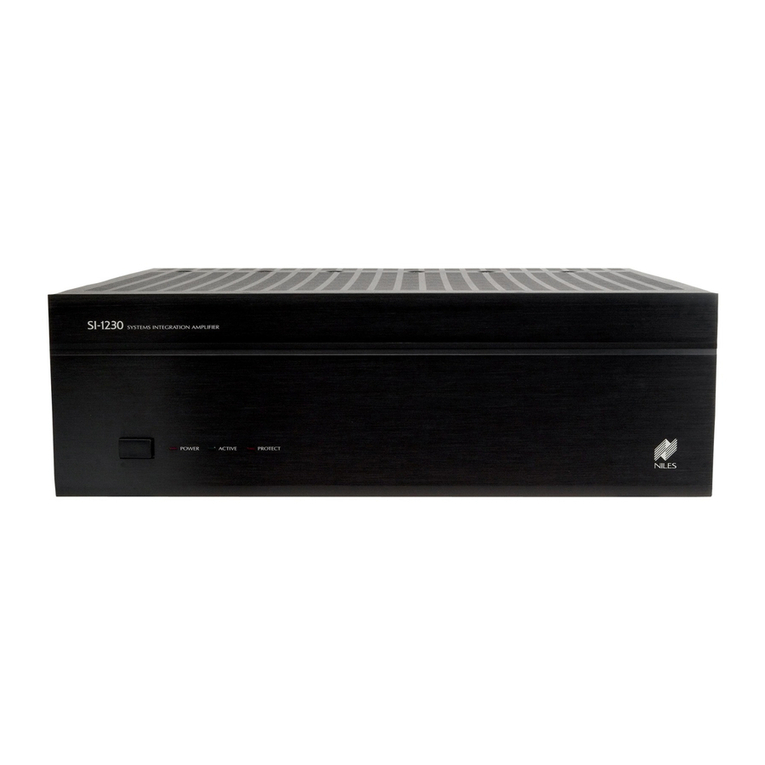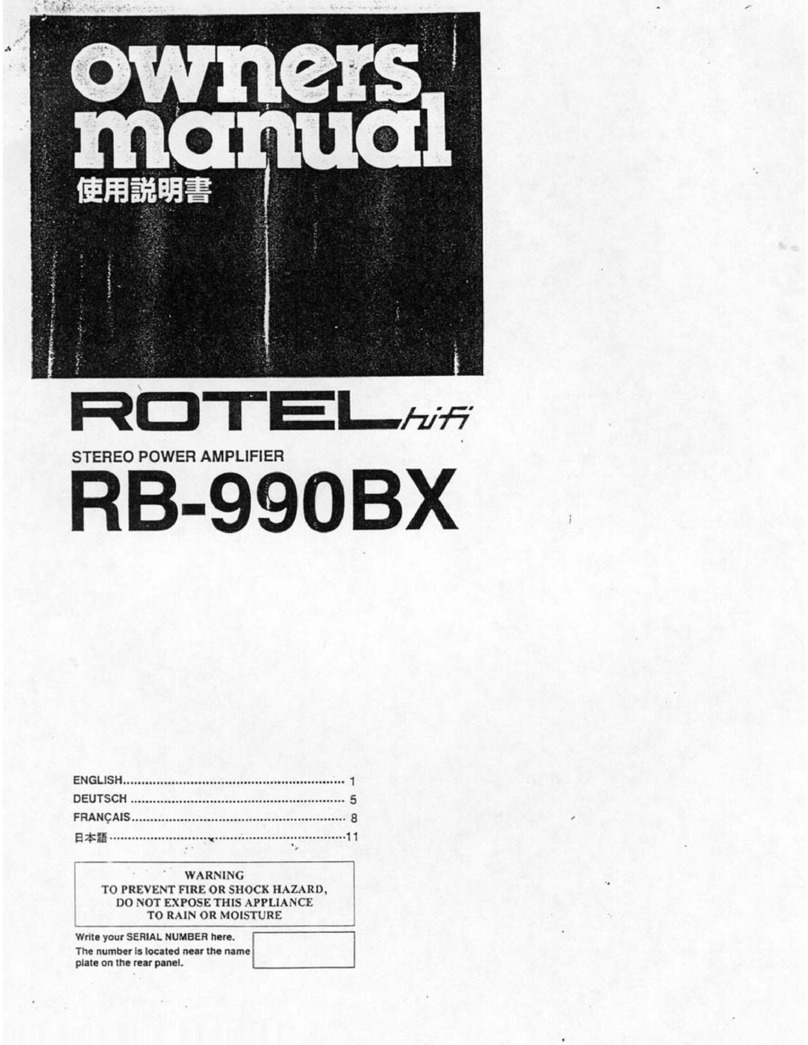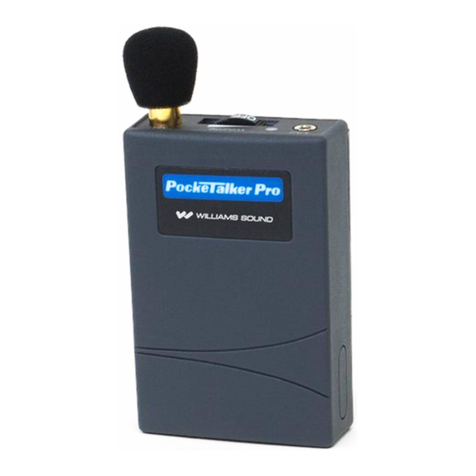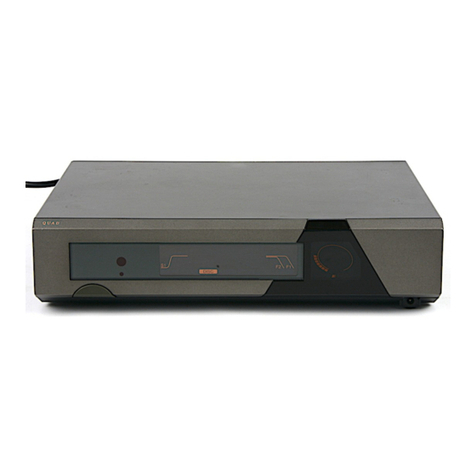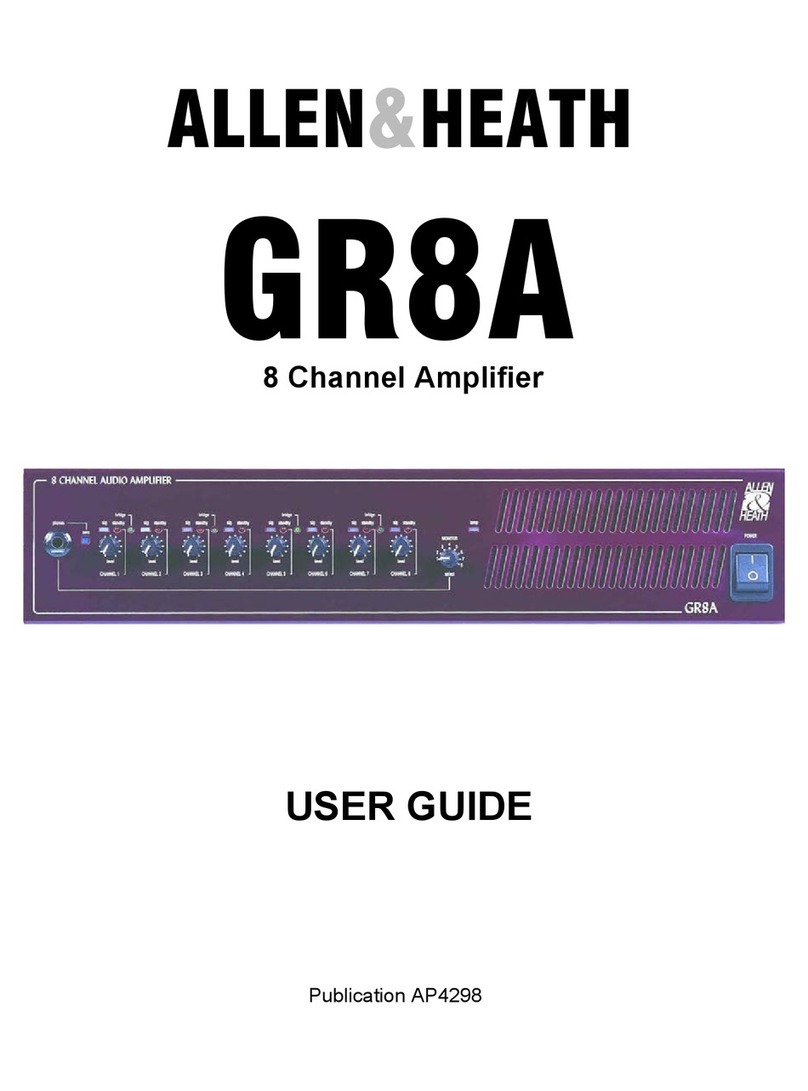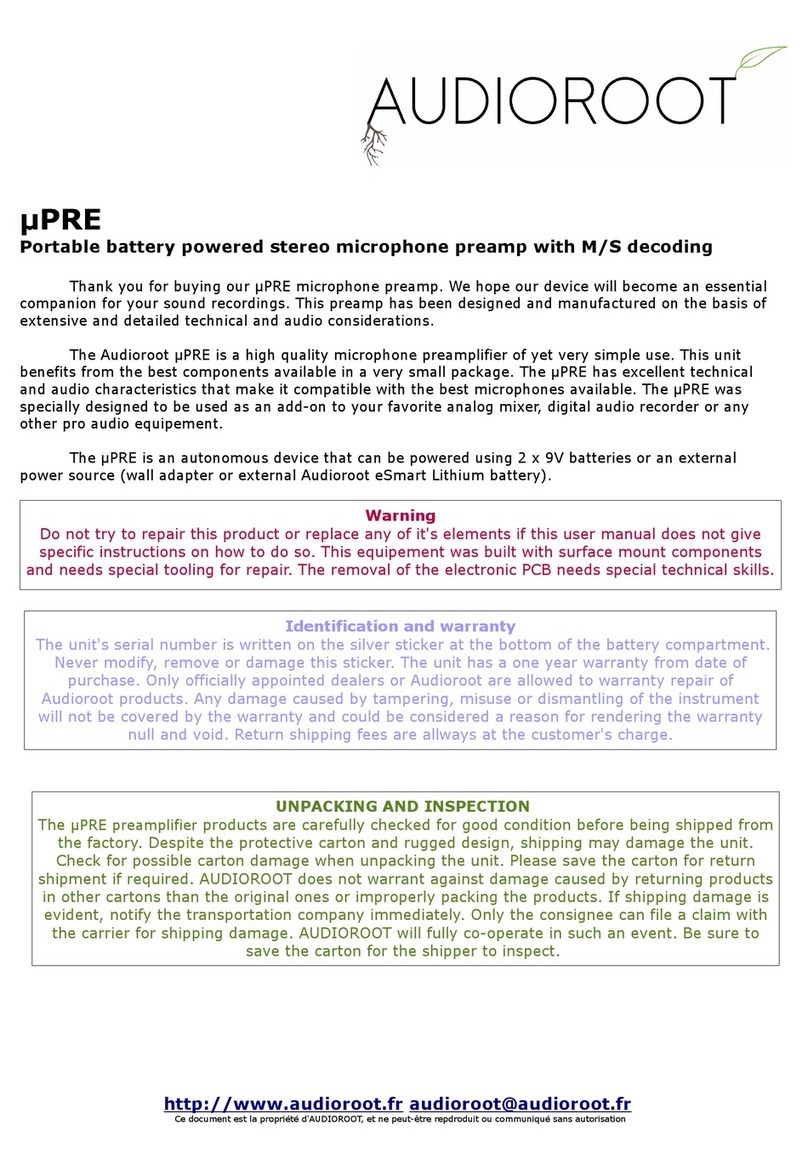Garmin Fusion Apollo MS-AP12000 User manual

A Garmin Brand
FUSION®
APOLLO™
MULTICHANNEL
AMPLIFIERS
Installation
Instructions
.......................2
lnstallatie-instructies
.........................
47
Instructions
d'installation
.....................9
lnstallationsvejledning
.......................
54
lstruzioni
di
installazione
...................
16
Asennusohjeet
..................................
61
lnstallationsanweisungen
..................
23
lnstalleringsinstruksjoner
...................
68
lnstrucciones
de
instalaci6n
..............
31
lnstallationsinstruktioner
...................
75
lnstru96es
de
instalac;ao
....................
39
~~:l=~~
.........................................
82
Garmin
•,
the
Garmin
logo,
Fusion
•,
Fusion-Link
·,
and
the
Fusion
logo
are
trademarks
of
Garmin
ltd.
or
its
subsidiaries,
registered
in
the
USA
and
other
countries.
These
trademarks
may
not
be
used
without
the
express
permission
of
Garmin.
M/N:
A03843
I
A03888
/
A03889
Printed in Taiwan
~.,.._
February 2023 •
190-02849-00_0A

Fusion®
Apollo"'
Multichannel
Amplifiers
Installation
Instructions
Important
Safety
Information
See
the
Important
Safety
and
Product
Information
guide
in
the
product
box
for
product
warnings
and
other
important
information.
This
device
must
be
installed
according
to
these
instructions.
Disconnect
the
power
supply
to
the
vessel's
audio
system
before
beginning
to
install
this
device.
&_CAUTION
Continuous
exposure
to
sound
pressure
levels
over
100
dBA
may
cause
permanent
hearing
loss
.
The
volume
is
typically
too
loud
if
you
cannot
hear
people
speaking
around
you.
Limit
the
amount
of
time
you
listen
at
high
volume
. If
you
experience
ringing
in
your
ears
or
muffled
speech,
stop
listening
and
have
your
hearing
checked.
To
avoid
possible
personal
injury,
always
wear
safety
goggles,
ear
protection:
and
a
dust
mask
when
drilling,
cutting,
or
sanding.
NOTICE
YOU
MUST
NOT
USE
THIS
AMPLIFIER
WITH
ANY
THIRD-PARTY
MARINE
AUDIO
SYSTEMS
.
This
amplifier
is
compatible
only
with
Fusion
•
DSP-enabled
marine
audio
equipment
and
may
cause
damage
to
third-party
speakers
due
to
the
amplifier
power
output.
When
drilling
or
cutting,
always
check
what
is
on
the
opposite
side
of
the
surface
to
avoid
damaging
the
vessel.
It
is
strongly
recommended
that
you
have
your
audio
system
installed
by
a
professional
installer
to
ensure
optimum
performance.
You
must
read
all
installation
instructions
before
beginning
the
installation.
If
you
experience
difficulty
during
the
installation,
go
to
support.garmin
.
com
for
product
support.
After
installing
an
audio
system,
you
should
run
the
connected
speakers
and
subwoofers
at
low
to
medium
volumes
during
their
first
few
hours
of
use
.
This
helps
to
improve
the
overall
sound
by
gradually
loosening
up
the
moving
components
in
the
new
speakers
and
subwoofers,
such
as
the
cone,
spider,
and
surround.
See
the
installation
instructions
provided
with
your
speakers,
because
there
may
be
more
details
about
the
recommended
low-to
-
medium
volume
usage
time
for
each
model.
NOTE:
After
installing
the
amplifier,
you
must
set
up
your
connected
stereo
using
the
Fusion-Link
"
app
to
select
and
activate
the
correct
DSP
profile.
Tools
Needed
2
40
A
inline
fuse
or
circuit
breaker
Drill
and
3
mm
(11
8
in.)
drill
bit
(or
adrill
bit
appropriate
for
your
provided
mounting
hardware
and
mounting-surface
material).
Screwdrivers:
0 5
mm
(7!
32
in.)
flat
(slotted)
0 4
mm
(5/
32
in.)
flat
(slotted)
0 3
mm
(1/8
in.)
flat
(slotted)
0
#2
Phillips
0
#0
Phillips
Wire
cutter
Wire
stripper
Wires
and
cables:
0 4
AWG
(21
through
25
mm
2)
marine-grade,
fully-tinned
copper
wire
for
power
and
ground
NOTE:
You
may
need
larger-diameter
(smaller
gauge
number)
wire
for
longer
runs
to
account
for
voltage
drop
(Connecting
to
Power,
page
4)
0
16
AWG
(1.3
through
1.5
mm
2)
marine-grade,
fully-tinned
copper
wire
for
standard
speakers
You
can
purchase
this
wire
from
your
Fusion
or
Garmin
"
dealer:
0
010-12899-00
:
7.62
m
(25
ft.)
0
010-12899-1
0:
15
.
24
m
(50
ft.)
0
12
AWG
(3
through
4
mm
2)
marine-grade,
fully-tinned
copper
wire
for
high-power
full-range
speakers
or
subwoofers
using
the
high
power
adapter
(bridged
mode)
You
can
purchase
this
wire
from
your
Fusion
or
Garmin
dealer:
0
010-12898-00
:7.
62
m
(25
ft.)
0
010-12898-10:
15.24
m
(50
ft.)
NOTE:
You
may
need
larger-diameter
(smaller
gauge
number)
wire
for
longer
runs
of
speaker
or
subwoofer
wire.
0
20
AWG
(0.5
through
0.75
mm
2)
marine-grade,
fully-tinned
copper
wire
for
the
remote-on
signal
0
2-channel
RCA
cable
(1
per
stereo
channel
pair)
(Signal
and
Speaker
Connection
Considerations,
page
5)
0
1-channel
RCA
cable
(1
per
mono
channel)
(Signal
and
Speaker
Connection
Considerations,
page
5)
You
can
purchase
a
suitable
length
of
RCA
cable
at
garmin.com
/apollo_amplifier_accessories
or
from
your
Fusion
or
Garmin
dealer.
Cable
ties
(optional)
Mounting
Considerations
In
high
ambient
temperatures
and
after
extended
use,
the
device
enclosure
may
reach
temperatures
deemed
dangerous
to
touch.
To
avoid
possible
personal
injury,
the
device
must
be
installed
in
a
location
where
it
will
not
be
touched
during
operation.
NOTICE
This
device
should
be
mounted
in
a
well-ventilated
location
that
is
not
exposed
to
extreme
temperatures
or
conditions.
The
temperature
range
for
this
device
is
listed
in
the
product
specifications
.
Extended
exposure
to
temperatures
exceeding
the
specified
temperature
range,
in
storage
or
operating
conditions,
may
cause
device
failure
.
Extreme-temperature-induced
damage
and
related
consequences
are
not
covered
by
the
warranty.
This
device
is
designed
for
installation
only
in
a
dry
location
.
Installing
this
device
in
a
location
where
it
may
come
in
contact
with
more
than
occasional
dripping
water
or
become
submerged
may
result
in
damage.
Water
damage
is
not
covered
by
the
warranty.
You
must
not
mount
this
device
upside-down
on
the
underside
of a
horizontal
mounting
surface.
Mounting
the
device
in
an
upside-down
orientation
reduces
the
effectiveness
of
heat
dissipation,
and
may
lead
to
shutdown
due
to
thermal
protection
.
If
you
are
mounting
the
device
on
fiberglass,
when
drilling
the
pilot
holes,
use
a
countersink
bit
to
drill a
clearance
counterbore
through
only
the
top
gel-coat
layer.
This
will
help
to
avoid
cracking
in
the
gel-coat
layer
when
the
screws
are
tightened.
You
can
mount
this
amplifier
·
using
one
of
two
methods:
You
can
use
the
included
bracket
and
pan
head
screws
to
mount
the
amplifier
(Installing
the
Mounting
Bracket,
page
3).
0
Mounting
the
amplifier
using
the
bracket
allows
you
to
quickly
attach
and
detach
the
amplifier
from
the
mounting
surface.
0
Mounting
the
amplifier
using
the
bracket
requires
clear
space
above
the
mounting
location
to
allow
for
connecting
the
amplifier
to
the
bracket
and
installing
the
locking
wedge.
You
can
use
the
included
flat-head,
countersunk
screws
to
mount
the
amplifier
directly
to
the
mounting
surface
(Mounting
the
Device
Directly
to
the
Surface,
page
4).
0
Mounting
the
amplifier
directly
to
the
surface
does
not
allow
you
to
quickly
detach
the
amplifier.
0
Mounting
the
amplifier
directly
to
the
surface
does
not
require
as
much
clear
space
above
the
mounting
location,
so
it
may
be
a
more
suitable
choice
for
installing
in
a
smaller
space.
When
selecting
a
mounting
location,
observe
these
considerations:
You
must
mount
the
amplifier
in
a
location
that
does
not
interfere
with
the
fuel
tank
or
electrical
wiring.
You
must
mount
the
amplifier
in
a
location
where
it
is
not
exposed
to
water.
You
must
mount
the
amplifier
in
a
location
where
it
is
not
exposed
to
fuel
or
fuel
vapor.
Installation
Instructions

You
must
mount
the
amplifier
in
a
location
with
adequate
ventilation
where
it
is
not
exposed
to
extreme
temperatures
.
If
you
mount
amplifier
in
an
enclosed
space,
you
should
install
a
cooling
fan
with
appropriate
ducts
to
aid
in
airflow.
You
should
mount
the
amplifier
so
that
the
cables
can
be
connected
easily.
You
must
not
mount
the
amplifier
upside-down
on
the
underside
of a
horizontal
mounting
surface
.
To
avoid
interference
with
a
magnetic
compass,
you
should
mount
the
amplifier
the
specified
distance
away
from
a
compass.
This
distance
is
listed
in
the
specifications
section
.
You
must
not
mount
the
amplifier
in
close
proximity
to
other
navigation-
critical
equipment,
antennas,
or
radio-communication
equipment
on
the
vessel.
Installing
the
Mounting
Bracket
NOTICE
Pan-head
screws
are
included,
but
they
may
not
be
suitable
for
the
mounting
surface
. If
you
provide
different
mounting
hardware,
you
must
not
use
fasteners
with
a
countersunk
head
.
Hardware
with
a
countersunk
head
will
damage
the
mounting
bracket.
Before
you
install
the
mounting
bracket,
you
must
select
a
mounting
location
and
determine
what
screws
and
other
mounting
hardware
are
needed
for
the
surface.
Mounting
the
device
using
the
mounting
bracket
allows
you
to
quickly
attach
and
remove
the
device
as
needed
.·
Use
the
included
template
to
verify
that
the
mounting
location
has
sufficient
clearance
to
install
the
device
.
NOTE:
You
must
install
the
bracket
with
the
release
tab
pointing
up
to
properly
secure
the
amplifier
in
the
bracket.
2
Using
a3
mm
(11a
in.)
bit
or
a
bit
appropriate
for
your
provided
hardware
and
mounting-surface
material,
drill
the
pilot
holes
marked
on
the
template
.
NOTICE
If
you
are
mounting
the
device
on
fiberglass,
when
drilling
the
pilot
holes,
use
a
countersink
bit
to
drill
a
clearance
counterbore
through
only
the top
gel-coat
layer
.
This
will
help
to
avoid
cracking
in
the
gel
-
coat
layer
when
the
screws
are
tightened
.
3
Using
the
included
pan-head
screws
or
other
pan-head
mounting
hardware,
secure
the
bracket
to
the
mounting
surface.
NOTICE
You
must
use
pan-head
screws,
because
countersunk
screws
will
damage
the
bracket.
Connecting
the
Device
to
the
Mounting
Bracket
You
must
secure
the
mounting
bracket
to
the
surface
before
you
can
connect
the
device.
1
Hold
the
device
over
and
slightly
above
the
mounting
bracket.
Installation
In
s
truct
i
on
s
. 2
Place
the
device
onto
the
bracket
G)
and
pull
down
®
until
the
tab
audibly
clicks.
3
Insert
the
wedge
over
the
tab
on
the
top
of
the
mounting
bracket
it
and
push
down
to
lock
the
device
in
the
bracket.
4
Install
the
included
screw
covers
in
the
four
holes
on
the
top
of
the
amplifier
(optional).
Removing
the
Device
from
the
Mounting
Bracket
1 Lift
up
to
remove
the
wedge
,
which
unlocks
the
tab
on
the
mounting
bracket.
2
Press
the
tab
<D
on
the
mounting
bracket,
and
lift
up
®
on
the
amplifier
to
disconnect
it
from
the
mount
®·
3

Mounting
the
Device
Directly
to
the
Surface
If
you
are
installing
the
device
in
a
location
with
limited
space
,
or
you
do
not
want
to
use
the
bracket,
you
can
mount
the
device
directly
to
the
surface
.
NOTE:
Countersunk
screws
are
provided
to
mount
the
device
directly
to
the
surface.
If
you
choose
to
use
your
own
hardware
to
mount
the
device
directly
to
the
surface,
countersunk
heads
are
recommended
.
1
Using
the
provided
template,
mark
the
pilot
hole
locations
for
the
four
mounting
holes
on
the
device,
observing
these
considerations:
Because
you
are
not
using
the
bracket,
you
do
not
need
to
observe
the
upper
clearance
line
on
the
template
.
You
must
observe
the
lower
clearance
line
on
the
template
so
that
you
have
the
space
needed
to
make
the
cable
connections
.
2
Using
a3
mm
(1/8
in
.)
bit
or
a
bit
appropriate
for
your
provided
hardware
and
mounting-surface
material,
drill
the
pilot
holes.
NOTICE
If
you
are
mounting
the
device
on
fiberglass,
when
drilling
the
pilot
holes,
use
a
countersink
bit
to
drill a
clearance
counterbore
through
only
the
top
gel-coat
layer.
This
will
help
to
avoid
cracking
in
the
gel-coat
layer
when
the
screws
are
tightened
.
3
Using
the
provided
countersunk
screws,
secure
the
device
to
the
mounting
surface
.
4
Install
the
included
screw
covers
in
the
four
holes
on
the
top
of
the
amplifier
(
optional)
.
Connection
Considerations
NOTICE
You
should
disconnect
the
power
supply
to
the
audio
syste
.m
before
making
any
connections
to
the
amplifier.
Failure
to
disconnect
the
audio
system
may
result
in
damage
to
the
amplifier
or
audio
system.
All
terminals
and
connections
must
be
protected
from
contact
with
other
conductive
materials,
such
as
the
vessel
chassis
and
other
wires.
Improper
terminal
or
wire
contact
may
result
in
damage
to
the
audio
system
.
When
routing
power
,
speaker,
and
RCA
cables,
make
sure
they
are
not
pinched
or
crushed.
A
pinched
cable
may
result
in
contact
with
other
conductive
materials
which
may
damage
the
audio
system
.
NOTE:
You
must
connect
the
amplifier
to
the
AMPLIFIER
ON
wire
from
the
stereo
for
the
amplifier
to
turn
on
and
off
with
the
stereo
.
When
selecting
and
routing
cables,
consider
the
following
:
You
should
use
RCA
signal
cables
that
are
of
the
appropriate
length
to
connect
the
stereo
to
the
amplifier.
Avoid
using
cables
that
are
much
longer
than
needed
.
When
routing
cables,
you
should
not
route
RCA
cables
alongside
the
power
cables
.
Routing
audio
cables
next
to
the
power
cables
may
introduce
interference
or
unwanted
noise
in
the
audio
signal.
•
When
routing
cables,
protect
them
from
sharp
objects
.
You
should
use
rubber
grommets
when
routing
cables
through
metal
panels
to
protect
the
cables
.
4
Port
Identification
MS-AP41200
4-Channel
Amplifier
MS-AP61800
6-Channel
Amplifier
MS-AP82400
8-Channel
Amplifier
(D
Power
block
port
(Connecting
to
Power,
page
4)
®
Zone
1
speaker
block
port
(Signal
and
Speaker
Connection
Considerations,
page
5)
@
Zone
1
RCA
input
©
Zone
2
speaker
block
port
1@
Zone
2
RCA
input
J
®
Zone
3
speaker
block
port
(J)
Zone
3
RCA
input
@
Zone
4
speaker
block
port
®
Zone
4
RCA
input
J
Connecting
to
Power
The
positive
wire
(not
included)
from
the
power
source
to
the
amplifier
must
run
through
a
40
A
in
line
fuse
or
circuit
breaker
(not
included)
as
close
to
the
power
source
as
possible.
Connecting
the
amplifier
to
power
withQut
an
in
line
fuse
or
circuit
breaker
may
result
in
a
fire
if
there
is
a
short
in
the
cable
.
You
should
use
4
AWG
(21
through
25
mm
2)
marine-grade,
fully
-
tinned
copper
wire
(not
included)
to
connect
the
amplifier
to
power
and
ground
for
most
installations
.
For
power-cable
runs
longer
than
5m
(16
ft.),
you
should
consider
using
larger-diameter
(smaller
gauge
number)
wire
to
minimize
power
loss
.
You
must
connect
the
REM
terminal
on
the
amplifier
block
to
either
the
AMPLIFIER
ON
wire
from
the
connected
stereo
or
to
a
constant
12
Vdc
power
source
using
a
switch
.
NOTICE
Connecting
to
the
AMPLIFIER
ON
wire
from
the
stereo
instead
of
using
an
external
switch
is
recommended
to
avoid
damaging
your
speakers
when
the
stereo
turns
on
or
off.
Install
ati
on
Instructions

Route
4
AWG
{21
through
25
mm
2)
marine-grade,
fully-tinned
copper
ground
wire
(not
included)
to
the
amplifier
and
to
a
ground
location
on
the
boat.
2
Using
a5
mm
{7/
32
in
.) flat
{slotted)
screwdriver,
connect
the
ground
wire
to
the
GND
terminal
on
the
power
connection
block.
3
Connect
the
other
end
of
the
ground
wire
to
the
ground
location.
4
Route
4
AWG
(21
through
25
mm
2)
marine-grade,
fully-tinned
copper
power
wire
(not
included)
to
the
amplifier
and
to
the
power
source.
5
As
close
to
the
power
source
as
possible
,
install
a
40
A
inline
fuse
on
the
power
wire
in
an
accessible
location
or
connect
the
power
wire
through
a
40
Acircuit
breaker.
Connecting
the
amplifier
to
power
without
a
40
A
inline
fuse
or
circuit
breaker
may
result
in
a
fire
if
there
is
a
short
in
the
cable.
0 0
0 0
6
Using
a5
mm
{7!
32
in
.) flat
{slotted)
screwdriver,
connect
the
power(+)
wire
to
the
PWR
terminal
on
the
power
connection
block.
7
Route
a
20
AWG
(0
.5
through
0.
75
mm
2)
marine-grade,
fully-tinned
copper
remote-on
wire
(not
included)
from
the
amplifier
to
the
AMPLIFIER
ON
wire
on
the
stereo
.
NOTE:
The
amplifier
and
the
stereo
must
connect
to
a
common
ground
terminal
point
for
the
AMPLIFIER
ON
signal
to
function
properly
.
8
Using
a4
mm
(5/
32
in
.) flat
{slotted)
screwdriver,
connect
the
remote-on
wire
to
the
REM
terminal
on
the
power
connection
block
.
NOTICE
You
should
wait
to
connect
the
power
terminal
block
to
the
amplifier.
Make
all
of
the
other
connections
to
the
stereo
and
speakers
before
completing
the
connection
to
power
{Completing
the
Connections,
page
6)
.
Signal
and
Speaker
Connection
Considerations
When
connecting
your
stereo
and
speakers
to
the
amplifier,
observe
the
following
considerations:
All
speakers
connect
to
the
amplifier
using
terminal
blocks
{Connecting
Standard
Full-Range
Speakers
to
the
Amplifier,
page
5).
When
connecting
standard
full
-
range
speakers,
you
should
use
16
AWG
(1.3
through
1.5
mm
2)
marine-grade,
fully-tinned
copper
wire
.
When
connecting
high-power
full-range
speakers
or
a
subwoofer
in
bridge
mode
using
the
included
high
power
adapter,
you
should
use
12
AWG
(3
through
4
mm
2)
marine
-
grade,
fully-tinned
copper
wire
{Connecting
High-
Power
Full-Range
Speakers
or
a
Subwoofer
to
the
Amplifier,
page
5)
.
•
Each
set
of
zone
speaker
terminals
on
the
amplifier
is
paired
to
the
RCA
inputs
for
that
zone.
Each
channel
supports
a
nominal
4
Ohm
speaker
load
impedance,
and
a
2
Ohm
minimum
speaker
load
impedance
.
You
can
connect
either
a
zone
line
out
or
a
subwoofer
line
out
from
the
stereo
to
any
of
the
zone
RCA
inputs
on
the
amplifier.
You
should
observe
the
zone
and
polarity
markings
for
each
channel
when
connecting
speakers
to
the
amplifier.
The
speaker
ports
for
each
zone
are
marked
with
negative(-)
and
positive(+)
for
the
left
(L)
and
right
(R)
channels
.
When
connecting
a
high-power
full-range
speaker
or
a
subwoofer
in
bridge
mode,
the
speaker
terminal
polarity
is
marked
on
the
high
power
adapter.
In
the
following
example,
a
single
4
Ohm
subwoofer
is
connected
to
ZONE
2
using
the
high
power
adapter,
and
pairs
of 4
Ohm
standard
full-range
Installation
Instructions
speakers
are
connected
to
the
right
and
left
channels
for
the
other
two
zones.
In
this
example,
you
must
connect
the
single
RCA
subwoofer
line
out
connector
from
the
stereo
(D
to
the
uncovered
L
RCA
port
for
ZONE
2
on
the
amplifier
@,
and
you
must
connect
the
two
RCA
zone
line
out
connectors
from
the
stereo
@to
the
other
two
zone
RCA
ports
on
the
amplifier©.
Connecting
Standard
Full-Range
Speakers
to
the
Amplifier
You
must
use
the
provided
terminal
blocks
to
connect
standard
full
-
range
speakers
to
the
amplifier.
1
Route
16
AWG
(1
.3
through
1.5
mm
2)
marine-grade,
fully
-
tinned
copper
speaker
wire
(not
included)
to
the
speakers
and
the
amplifier.
NOTE:
You
should
label
both
ends
of
the
speaker,
including
polarity,
so
you
can
easily
identify
which
wires
route
to
which
speakers
.
2
Connect
the
speaker
wire
to
the
speakers
,
observing
polarity.
NOTE:
Incorrectly
connecting
the
speaker
wire
by
crossing
the
polarity
may
result
in
poor
sound
quality.
3
Using
a
#0
Phillips
or
a3
mm
(1/s
in
.) flat
{slotted)
screwdriver
,
connect
the
speaker
wires
to
the
speaker
terminal
blocks,
observing
the
polarity.
NOTE:
The
speaker
terminal
blocks
are
not
labeled
.
Refer
to
the
labels
on
the
amplifier
ports
when
determining
polarity.
4
When
all
speaker
wires
are
connected
to
the
terminal
block,
press
the
assembled
terminal
block
into
the
appropriate
ZONE
port
on
the
amplifier
to
complete
the
speaker
connection
for
the
zone.
5
Use
a
2-channel
RCA
cable
(not
included)
to
connect
the
RCA
zone
line
out
connectors
from
the
stereo
to
the
RCA
input
ports
for
the
appropriate
zone
on
the
amplifier
{Signal
and
Speaker
Connection
Considerations,
page
5).
6
Repeat
this
procedure
for
all
of
the
speakers
you
want
to
connect
to
the
amplifier.
Connecting
High-Power
Full-Range
Speakers
or
a
Subwoofer
to
the
Amplifier
NOTICE
The
provided
high
power
adapter
places
two
adjacent
channels
into
bridged
mode
.
You
should
connect
only
one
4
Ohm
high-power
full-range
speaker
or
subwoofer
to
the
amplifier
when
using
the
high
power
adapter
.
Connecting
a
load
of
less
than
4
Ohm
when
using
the
high
power
adapter
may
cause
damage
to
the
amplifier,
speakers,
or
subwoofers
.
You
must
install
the
provided
high
power
adapter
on
the
speaker
terminal
block
when
connecting
a
high
-
power
full
-
range
speaker
or
subwoofer
to
5

a
zone.
This
adapter
guarantees
that
the
correct
speaker
terminals
are
connected
and
it
signals
to
the
amplifier
that
the
zone
is
operating
in
high
-
power
mode
(commonly
referred
to
as
bridged
mode)
.If
needed,
you
can
purchase
additional
adapters
from
your
Fusion
dealer
.
1
Place
the
high
power
adapter
over
an
empty
speaker
terminal
block
and
press
until
it
clicks
in
place
.
~
2
Route
12
AWG
(3
through
4
mm
2)
marine
-
grade,
fully-tinned
copper
speaker
wire
(not
included)
to
the
high-power
full-range
speaker
or
subwoofer
and
the
amplifier.
NOTE:
You
should
label
both
ends
of
the
speaker
wire,
including
polarity,
so
you
can
easily
identify
which
wires
route
to
which
speakers
.
3
Connect
the
speaker
wire
to
the
full-range
speaker
or
subwoofer,
observing
polarity.
NOTE:
Incorrectly
connecting
the
speaker
wire
by
crossing
the
polarity
may
result
in
poor
sound
quality
.
4
Using
a
#0
Phillips
or
a3
mm
(1/8
in
.) flat
(slotted)
screwdriver
,
connect
the
speaker
wires
to
the
speaker
terminal
blocks
,
observing
the
polarity
labeled
on
the
high
power
adapter
cover
.
5
When
both
speaker
wires
are
connected
to
the
terminal
block
using
the
high
power
adapter,
insert
the
assembled
terminal
block
into
the
appropriate
ZONE
port
on
the
amplifier
to
complete
the
connection
for
the
zone
.
6
Complete
an
action
:
If
you
are
connecting
a
subwoofer,
connect
a
1-channel
RCA
cable
(not
included)
to
the
RCA
subwoofer
line
-
out
connector
from
the
stereo
for
a
zone
you
want
to
use
with
the
subwoofer.
If
you
are
connecting
high-power
full-
range
speakers,
connect
a
2-
channel
RCA
cable
(not
included)
to
the
RCA
zone
out
connector
from
the
stereo
for
a
zone
you
want
to
use
with
the
high-power
full
-
range
speakers
.
7
Connect
the
other
end
of
the
RCA
cable
from
the
stereo
to
the
open
RCA
input
port
G)
for
the
channel
powering
the
subwoofer
or
the
channels
powering
the
high
-
power
full-
range
speakers
.
RCA
channel
connector
to
the
RCA
port
on
the
amplifier
for
the
channel
powering
the
right
high-power
speaker.
8
Repeat
this
procedure
for
additional
high
-
power
full-range
speakers
or
additional
subwoofers
.
Completing
the
Connections
Before
you
connect
the
amplifier
to
the
power
source,
you
should
complete
all
other
connections
to
the
amplifier
.
1
Make
sure
all
speaker
wires
are
connected
between
the
speakers
and/or
subwoofer(s)
and
the
amplifier,
using
speaker
terminal
blocks
.
2
Make
sure
all
RCA
cables
are
connected
between
the
stereo
and
the
amplifier.
3
Make
sure
the
power
and
ground
cables
are
connected
to
the
power
terminal
block
and
the
power
source
(Connecting
to
Power,
page
4)
.
4
Make
sure
the
amplifier
remote-on
wire
is
connected
to
the
power
terminal
block
and
to
the
amplifier
turn-on
wire
from
the
stereo
(Connecting
to
Power,
page
4)
.
5
Insert
the
assembled
power
terminal
block
into
the
power
port
on
the
left
side
of
the
amplifier.
6
Using
a5
mm
(7!
32
in
.) flat
(slotted)
screwdriver,
secure
the
power
terminal
block
to
the
amplifier.
NOTICE
After
you
have
completed
all
connections,
you
must
configure
the
DSP
profile
for
the
amplifier
before
playing
music
. If
the
DSP
profile
is
not
set
up,
you
may
damage
the
connected
speakers
(Configuring
the
Amplifier,
page
6).
Configuring
the
Amplifier
To
configure
the
amplifier
for
use
with
your
stereo
and
speakers,
you
must
use
the
Fusion-Link
app
to
set
up
the
DSP
profile
after
you
have
completed
the
connections.
TIP:
You
can
view
a
video
tutorial
to
help
set
up
a
DSP
profile
for
your
system
at
garmin.com/videos/fusion_link_app.
1
Follow
the
instructions
in
your
stereo
owner
's
manual
to
download
the
Fusion
-
Link
app
and
connect
it
to
the
stereo
.
2
Select
the
appropriate
amplifier,
speakers,
and/or
subwoofer(s)
for
each
zone
in
the
Fusion-Link
app
.
3
Follow
the
instructions
in
the
Fusion
-
Link
app
to
select
a
configured
profile
for
the
connected
amplifier,
speakers,
and/or
subwoofer(s)
.
4
Send
the
DSP
profile
to
the
connected
stereo
and
test
the
sound
.
5
Repeat
steps
3
and
4
until
the
audio
system
sounds
satisfactory
.
Specifications
Compass-safe
distance
-------------
Operating
temperature
range
Storage
temperature
range
•
Water
rating
MS
-
AP41200:
75
cm
(30
in.)
MS-AP61800:
145
cm
(57
in.)
MS-AP82400:
245
cm
(96
1/2
in.)
From
O
to
SO"C
(from
32
to
122
'
F)
From
-20
to
70°C
(from
-4
to
158"F)
IEC
60529
IPX2
1
NOTE:
Each
high-power
full-range
speaker
connects
to
only
one
channel
from
the
2-
channel
RCA
cable
from
the
stereo
.
Be
sure
to
connect
the
left
Maximum
wire
gauge
Power:
2
AWG
(33
.
63
mm
2)
Speakers:
12
AWG
(3.31
mm2)
RCA
channel
connector
to
the
RCA
port
on
the
amplifier
for
the
channel
powering
the
left
high
-
power
full-range
speaker
,
and
to
connect
the
right
1
Protection
aga
i
nst
v
erti
c
ally-dripping
water
when
installed
properly
with
the
conne
c
tors
pointing
downward.
6
Installation
Instructions

Weight
Amplifier
class
Frequency
response
CEA-2006
power
rating
per
channel
@
14
.4
Vdc,
4
Ohm,
:s
1%
THD+N,
1
kHz,
AES17-20
kHz
BW
CEA
-
2006
power
rating
per
channel@
14.4
Vdc,
2
Ohm,
:s
1%
THO+N,
1
kHz,
AES17-20
kHz
BW
CEA-2006
power
rating
per
channel
@
14.4
Vdc,
4
Ohm
bridged,
:s
1%
THO+N,
1
kHz,
AES17-20
kHz
BW
2
MS-AP41200:
2.2
kg
(4
lbs
13
.6
oz)
MS-AP61800
:2.7
kg
(5
lbs
15
.2
oz)
MS-AP82400
:3.
15
kg
(6
lbs
15
.1
oz)
Class
D
20
Hz
to
20
kHz
150
W
RMS
per
channel
290
W
RMS
per
channel
580
W
RMS
per
channel
-------------------•'---~--
Peak
power
output
Input
impedance
Input
sensitivity@
rated
power
output,
40hm
Signal
to
noise
ratio
@
rated
power
output,
4
Ohm
Signal
to
noise
ratio
@1
W,
4
Ohm
Separation/crosstalk
Operating
voltage
Current
draw,
in
standby/off
using
AMPLIFIER
ON
wire
(@14.4
Vdc
input)
Current
draw,
on,
no
audio
(@14
.4
Vdc
input)
MS-AP41200
:
1200
W
MS-AP61800
:
1800
W
MS-AP82400
:
2400
W
22
kOhm
1.6
Vrms
All
models:
97
dBA
All
models:
75
dBA
MS-AP41200
:
61
dB
MS-AP61800:
58
dB
MS-AP82400:
58
dB
10
.8
to
16
Vdc
less
than
5
mA
MS-AP41200
:
1.15
A
MS-AP61800:
1.32
A
MS
-
AP82400:
1.6A
Power-cable
fuse
or
circuit
breaker
rating
40
A
(not
included)
Remote
turn-on
Protection
circuits
Dimensions
Greater
than
4
Vdc
Reverse
voltage
Input
under/over
voltage
Over
temperature
Output
short
circuit
1----
-
----1J.,,}.-
----
--l
--
/!.=========:c::
~
.....
0
0-,
0
<[
iii.iliiiiiiiii,t I
~~
•
IJ
NOTE:
A
MS-AP41200
amplifier
is
shown
for illustration
purposes
.
Refer
to
the
table
for model-specific
measurements
.
<D
MS-AP41200:
235
mm
(9
1/4
in.)
MS-AP61800:
297
mm
(11
11
'16
in.)
MS-AP82400:
359
mm
(14
1/8
in
.)
180
mm
(7
1/15
in
.)
@
More
Information
Troubleshooting
Before
you
contact
your
Fusion
dealer
or
service
center,
you
should
perform
a
few
simple
troubleshooting
steps
to
help
diagnose
the
problem
.
If
the
Fusion
amplifier
has
been
installed
by
a
professional
installation
company,
you
should
contact
the
company
so
a
technician
can
assess
the
problem
and
advise
you
about
possible
solutions.
LED
Power
Indicator
Bar
Colors
The
single
LED
power
indicator
bar
on
the
amplifier
changes
colors
to
indicate
status
and
potential
faults.
You
can
use
these
LED
color
reference
tables
when
troubleshooting
the
amplifier.
LED
Color
Status
Off
Power
off
Green
Operational
Orange
Recoverable
fault
Red
Critical
fault
LED
Is
Off
C
Potential
Potential
Resolution
ause
Power
connec-
tion
issue
(Connecting
to
Power,
page
4)
Remote
turn-
on
wire
connection
is
s
ue
•
Check
the
power
wiring
connections
to
the
power
terminal
block
and
make
sure
they
are
securely
connected
using
the
terminal
screws
.
Check
the
connection
between
the
power
terminal
block
and
the
amplifier,
and
make
sure
the
power
terminal
block
is
seated
securely
in
the
port
.
Check
the
power
wiring
connections
to
the
inline
fuse,
circuit
breaker
(if
applicable),
and
battery,
and
repair
or
tighten
any
disconnected
or
loose
wires.
Check
the
inline
fuse
(if
applicable),
and
replace
it
if
the
fuse
is
blown
.
If
the
fuse
blows
again,
disconnect
the
amplifier
from
power
and
contact
Garmin
Support
(
support
.garmin
.
com)
.
Check
the
circuit
breaker
(if
applicable),
and
reset
it
if
necessary.
If
the
breaker
continues
to
trip,
disconnect
the
amplifier
from
power
and
contact
Garmin
Support
(support
.
garmin.com).
•
If
you
connected
a
subwoofer
or
high-power
full-range
speakers
using
the
high-power
adapter
(bridged
mode),
check
the
settings
in
the
OSP
profile
.
Using
generic
or
no
profile
settings
with
speakers
in
bridged
mode
may
cause
power
issues.
Make
sure
the
supply
voltage
is
within
the
specified
operating
range
for
the
amplifier.
•
Make
sure
you
are
using
the
appropriate
gauge
for
the
length
of
the
power
cable
run,
and
replace
the
cable
with
a
thicker
gauge,
if
needed.
Check
the
remote
turn-on
wire
connection
to
the
power
terminal
block
and
make
sure
it
is
securely
connected
using
the
terminal
screws
.
Check
the
remote
turn-on
wire
connection
to
the
stereo
and
repair
or
tighten
a
disconnected
or
loose
wire
.
Make
sure
the
stereo
and
the
amplifier
are
connected
to
a
common
ground
.
If
you
connected
the
remote
turn
-
on
wire
to
a
switch
instead
of
the
stereo,
make
sure
the
switch
is
installed
correctly
.
··--····--··-··
··--------
2
Two
adjacent
channel
sof
the
amplifier
are
placed
in
bridged
mode
when
using
the
high
po
wer
adapter.
Installation
Ins
truct
i
ons
7

LED
Is
Green
and
There
Is
No
Sound
Potential
. .
Cause
Potential
Resolution
Power
or
volume
issue
DSP
settings
issue
Signal
or
speaker
connection
issue
RCA
channel
or
cable
issue
Intermittent
power
issue
•
Make
sure
the
stereo
is
powered
on.
Make
sure
the
volume
is
not
set
too
low
or
muted.
Check
the
volume
limit
setting
on
the
stereo.
A
low
limit
setting
may
result
in
volume
issues.
-----------
Check
the
DSP
settings
in
the
Fusion-Link
app
and
make
sure
the
correct
speakers
and
amplifier
are
selected.
NOTE:
After
you
configure
the
settings,
you
must
select
the
option
in
the
app
to
send
the
DSP
settings
to
the
devices.
Check
the
RCA
cable
connections
to
the
stereo
and
the
amplifier,
and
re-connect
all
disconnected
cables,
if
needed.
Check
the
speaker
wiring
connections
to
the
speaker
terminal
blocks
and
make
sure
they
are
securely
connected
using
the
terminal
screws.
Reconnect
or
tighten
the
wires,
if
needed.
Check
the
connection
between
the
speaker
terminal
blocks
and
the
amplifier,
and
make
sure
the
speaker
terminal
blocks
are
seated
securely
in
the
ports.
Check
the
wire
gauge
used
to
connect
the
speakers
to
the
amplifier,
and
make
sure
it
is
appropriate
for
the
length
of
the
wire
run
(Signal
and
Speaker
Connection
Considerations,
page
5).
Check
the
RCA
cable
for
damage
and
replace
it if
needed.
Check
the
RCA
cable
connection
to
the
stereo
and
make
sure
it
is
connected
to
the
intended
output.
If
the
RCA
cable
is
connected
to
the
intended
output,
try
connecting
it
to
another
zone
output
from
the
stereo
to
determine
if
there
may
be
an
issue
with
the
stereo.
Check
the
power
cables
to
make
sure
they
are
the
appropriate
gauge,
are
fused,
and
are
connected
properly
(Connecting
to
Power,
page
4).
LED
Is
Green
and
the
Sound
Is
Not
Optimal
Issue
Potential
Resolution
There
is
a
hum
or
other
unex-
pected
noise
from
a
speaker
The
sound
is
distorted
or
clipping
Bass
response
is
reduced
or
uneven
8
Route
the
RCA
cables
away
from
other
cables,
especially
power
cables.
Routing
RCA
cables
alongside
power
cables
may
introduce
interference
or
unwanted
noise
in
the
audio
signaL
Install
ground-loop
isolators
inline
with
the
RCA
cables
from
the
stereo.
NOTE:
You
should
install
ground-loop
isolators
on
the
RCA
cables
where
they
connect
to
the
stereo,
not
where
they
connect
to
the
amplifier.
Check
the
DSP
settings
in
the
Fusion-Link
app
and
make
sure
the
correct
amplifier,
speakers,
and/or
subwoofer
are
selected
.
NOTE:
After
you
configure
the
settings,
you
must
select
the
option
in
the
app
to
send
the
DSP
settings
to
the
devices.
Check
the
polarity
of
the
subwoofer
wires
and
correct
it if
needed.
Check
the
DSP
settings
in
the
Fusion-Link
app
and
make
sure
the
correct
amplifier,
speakers,
and/or
subwoofer
are
selected.
In
the
DSP
settings,
try
different
phase
settings
for
the
subwoofer
out
to
see
ifit
sounds
better.
NOTE:
After
you
configure
the
settings,
you
must
select
the
option
in
the
app
to
send
the
DSP
settings
to
the
devices.
LED
Is
Orange
Potential
Cause
Potential
Resolution
Power
supply
under-
or
over-
voltage
issue
Check
the
input
power
to
make
sure
it
is
within
the
10.8
to
16
Vdc
operational
range
for
the
amplifier.
•
Power
wire
gauge
issue
Check
the
wire
gauge
used
to
connect
the
amplifier
to
power,
and
make
sure
it
is
appropriate
for
the
length
of
the
wire
run.
Over-temperature
issue
Check
the
temperature
of
the
amplifier
and
make
sure
it
is
under
so•c
(122°F).
If
the
amplifier
is
hotter
than
the
operational
temperature
rating,
add
ventilation
to
the
installation
location
or
mount
the
amplifier
in
a
different
location.
NOTE:
The
amplifier automatically attempts
to
recover
from
a
recoverable
fault
(orange
LED).
If multiple attempts
at
recovery
are
not
successful,
the
amplifier transitions to acritical fault
status
(red
LED).
You
disconnect
the
amplifier
from
the
power
source
for
one
minute,
and
then
reconnect
it
or
toggle
the
AMPLIFIER
ON
signal
to
reset
the
critical fault.
LED
Is
Red
~:~:~tial
Potential
Resolution
Power
wire
gauge
issue
Power
supply
under-
or
over-
voltage
issue
Prolonged
over-
temperature
issue
DSP
setting
or
volume
issue
Speaker
fault
Internal
amplifier
or
power
supply
fault
Check
the
wire
gauge
used
to
connect
the
amplifier
to
power,
and
make
sure
it
is
appropriate
for
the
length
of
the
wire
run.
If
you
are
using
high-power
full-range
speakers
or
subwoofers,
you
should
consider
increasing
the
power
cable
gauge
(smaller
number).
Check
the
input
power
to
make
sure
it
is
within
the
specified
•
voltage
operating
range
for
the
amplifier.
If
the
amplifier
experiences
a
number
of
under-voltage
faults
(orange
LED)
in
a
short
period
of
time.
it
considers
the
issue
a
critical
fault
and
changes
the
LED
color
to
red.
A
series
of
orange
indicators
followed
by
a
red
indicator
may
indicate
an
under-voltage
issue.
Check
the
temperature
of
the
amplifier
and
make
sure
it
is
under
so·c
(122°F).
If
the
amplifier
is
hotter
than
the
opera-
tional
temperature
rating,
add
ventilation
to
the
installation
location
or
mount
the
amplifier
in
a
different
location.
Check
the
DSP
settings
in
the
Fusion-Link
app
and
make
sure
the
correct
amplifier,
speakers,
and/or
subwoofers
are
selected.
NOTE:
After
you
configure
the
settings,
you
must
select
the
option
in
the
app
to
send
the
DSP
settings
to
the
stereo.
Check
all
of
the
connected
speaker
wires.
Make
sure
the
speaker
wires
are
connected
to
the
speaker
terminal
blocks
and
to
the
speakers
properly.
Make
sure
there
are
no
shorts
in
the
speaker
wires,
and
there
are
no
cuts
in
the
speaker-wire
jackets
that
may
result
in
a
short.
Disconnect
the
amplifier
from
the
power
source
for
one
minute,
and
then
reconnect
it
and
test
for
proper
operation.
If
the
LED
continues
to
show
a
red
fault,
contact
Garmin
Support
(support.garmin.com).
fl'•fl'W4tl.Btldt:dt
+a-
*
ti
;A{f)-~
:fb~IIVt
:ft.~=~•
0 0 0 0 0 0
0 0 0 0 0 0
0 0 0 0 0 0
Installation
Instructions

FUSl!i1i'
A
Garmin
Brand
Apollo™ MS-AP12000
Apollo MS-AP41200
Mounting Template
25mm
(1
in.)
Clearance
required
Degagement
requis
Spazio
libero
richiesto
Freiraum
erforderlich
Espacio
necesario
Necessario
abrir
espar;o
Pakrrevet
afstand
Vereiste
spe/ing
N0dvendig
klaring
Frift
utrymme
kravs
■
~lllifEiJ~ilt
78mm
100
mm
(4
in.)
clearance
required
when
mounting
using
the
bracket.
25
mm
(1
in.)
required
when
mounting
the
amplifier
directly
to
the
surface
.
Degagement
de
100
mm
(4
po)
requis
/ors
de
/'installation
a
/'aide
du
support.
25
mm
(1
po)
requis
/ors
de
/'installation
de
l'ampli
directement
sur
la
surface
.
E
necessario
disporre
di
100
mm
(4
pollici)
di
spazio
libero
per
effeftuare
ii
montaggio
utilizzando
la
staffa
.E
necessario
disporre
di
25
mm
(1
po/lice)
per
montare
l'
amplificatore
direftamente
sul/a
superficie
.
100
mm
(4
Zoll)
Freiraum
bei
Montage
mit
der
Halterung
erforderlich
.
25
mm
(1
Zoll)
erforderlich
,
wenn
der
Verstarker
direkt
auf
der
Montagef/ache
montiert
wird.
Es
necesario
un
espacio
de
100
mm
(4
in)
para
el
montaje
con
el
soporte
.
Sise
manta
el
amplificador
directamente
en
la
superficie
,
sera
necesario
un
espacio
de
25
mm
(1
in)
.
E
preciso
abrir
um
espai;o
de
100
mm
(4
pol.)
quando
a
montagem
e
feita
usando
o
suporte
.
No
caso
da
montagem
do
amplificador
diretamente
na
superficie
,
s6
e
preciso
abrir
um
espai;o
de
25
mm
(1
pol.)
.
100
mm
(4
in
.)
pakrrevet
afstand
ved
montering
med
bes/aget.
25
mm
(1
in.)
pakrrevet
ved
montering
afforstrerkeren
direkte
pa
overfladen
.
100
mm
(4
inch)
speling
vereist
bij
montage
met
de
steun
.
25
mm
(1
inch)
vereist
voor
directe
montage
van
de
versterker
op
het
oppervlak
.
100
mm
(4
tommer)
n0dvendig
klaring
ved
montering
av
brakeften
.
25
mm
(1
tomme)
n0dvendig
klaring
ved
montering
av
forsterkeren
direkte
pa
overflaten
.
100
mm
(4
tum)
frift
utrymme
kravs
nar
man
monterar
med
fastet
.
25
mm
(1
tum)
kravs
nar
forstarkaren
monteras
direkt
pa
ytan
.
~m:sz:~'?'.i:~81
■
~11±1100
~*
(4
~'J)
f
B]~ilt
, 1~$7':8iJi'?'.i:~iUWlffiB1m~ll±125
~*
(1
~'J)
fB][i
,
□
(3
1/
15
in.)
25mm
(1
in.)
80mm
(3
1
/s
in.)
fu-l
185.5mm
133mm
(5
¼
in.)
Clearance
required
Degagement
requis
Spazio
libero
richiesto
Freiraum
erforder/ich
Espacio
necesario
Necessario
abrir
espar;o
Pakrrevet
afstand
Vereiste
speling
N0dvendig
klaring
Frift
utrymme
kravs
■
~I
1±1
fEiJ~ili
Provide
sufficient
clearance
for
the
cable
bending
radius
and
to
allow
room
for
the
tool
used
to
secure
the
power
terminal
block
to
the
amplifier
.
Required
for
both
mounting
options.
Veillez
a
laisser
un
ecart
suffisant
se/on
le
rayon
de
courbure
du
cable
et
pour
utiliser
/es
outils
qui
permeftent
de
fixer
le
bornier
d'alimentation
a
l'ampli
.
Requis
pour
/es
deux
options
di.montaggio.
Lasciare
spazio
libero
sufficiente
per
ii
raggio
di
curvatura
def
cavo
e
per
consentire
/'uso
de/lo
strumento
per
fissare
la
morseftiera
a/l'amplificatore.
Questa
e
necessario
per
entrambe
leiten
erforderlich.
Lassen
Sie
ausreichend
Freiraum
tar
den
Biegeradius
des
Kabels
und
zum
Verwenden
des
Werkzeugs
zum
Befestigen
des
Stromanschlussb/ocks
am
Verstarker.
Fur
beide
Befestigungs.v1taje.
Deja
suficiente
espacio
para
el
radio
de
curvatura
def
cable
y
para
poder
usar
la
herramienta
para
fijar
el
b/oque
de
termina/es
de
alimentaci6n
al
amplificador.
Necesario
para
ambas
opcie
montagem.
Abra
espai;o
suficiente
para
o
raio
de
curvatura
do
cabo
eo
manuseio
da
ferramenta
usada
para
prender
o
bloco
de
terminais
de
energia
ao
amplificador.
lsso
e
necessario
para
ambas
a;s
,
S0rg
for
tilstrrekke/ig
afstand
ti/
kablets
b0jningsradius
og
ti/
at
give
plads
ti/
vEErkt0jet,
som
bruges
ti/
at
fastg0re
str0mklemrEEkken
ti/
forstEErkeren.
KrEEves
ti/
begge
monteringsmulighedereist
voor
beide
Zorg
voor
voldoende
ruimte
voor
de
buigradius
van
de
kabel
en
om
ruimte
te
maken
voor
het
gereedschap
dat
wordt
gebruikt
om
het
aansluitblok
voor
de
voeding
aan
de
versterker
te
t~·
montageopties.
S0rg
for
tilstrekkelig
klaring
for
kabelb0yradiusen
og
nok
plass
ti/
verkt0yet
som
ska/
brukes
ti/
a
feste
stmmrekkeklemmen
ti/
forsterkeren.
N0dvendig
for
begge
monteringsa/ternat,ativen.
Se
till
aft
det
finns
tillrackligt
med
spel
for
kabelbojningsradien
och
for
aft
ge
plats
at
verktyget
som
anvands
for
aft
fasta
stromkopplingsplinten
pa
forstarkaren.
Kravs
for
bada
mont1::1
tt~
~
-~~*~~m~,~~ij-#~m~ffl
~
~m~•~~~$*
■
~I~11±1~
ij
,~~'?'.i:~~~~•
~
11±1
~
ij,
September
2022
©
2021
Garmin
ltd.
or
its
subsidiaries
Printed
in
Taiwan
M
190-02849-04
_
oc
~
PAP

IMPORTANT SAFETY AND PRODUCT INFORMATION
WARNING
Failure to heed the following warnings could result in an
accident resulting in death or serious injury.
Marine Operation Warnings
•You are responsible for the safe and prudent operation
of your vessel. This device does not relieve you
from the responsibility of safely operating your vessel.
Avoid navigational hazards and never leave the helm
unattended.
• Always be prepared to promptly regain control of the
vessel. Use caution near hazards in the water, such as
docks, pilings and other vessels.
Hearing Damage Warning
Listening to the stereo at high volume can cause damage
to your hearing.
Product Environmental Programs
Information about the Garmin® product recycling program
and WEEE, RoHS, REACH, and other compliance programs
can be found at garmin.com/aboutGarmin/environment.
Declaration of Conformity
Hereby, Garmin declares that this product is in compliance
with the Directive 2014/53/EU. The full text of the EU
declaration of conformity is available at the following
internet address: garmin.com/compliance.
UK Declaration of Conformity
Hereby, Garmin declares that this product is in compliance
with the relevant statutory requirements. The full text of
the declaration of conformity is available at the following
internet address: garmin.com/compliance.
FCC Compliance
This device complies with part 15 of the FCC Rules.
Operation is subject to the following two conditions:
(1) this device may not cause harmful interference,
and (2) this device must accept any interference
received, including interference that may cause undesired
operation.
This equipment has been tested and found to comply with
the limits for a Class B digital device, pursuant to part
15 of the FCC rules. These limits are designed to provide
reasonable protection against harmful interference in a
residential installation. This equipment generates, uses,
and can radiate radio frequency energy and may cause
harmful interference to radio communications if not
installed and used in accordance with the instructions.
However, there is no guarantee that interference will not
occur in a particular installation. If this equipment does
cause harmful interference to radio or television reception,
which can be determined by turning the equipment off
and on, the user is encouraged to try to correct the
interference by one of the following measures:
• Reorient or relocate the receiving antenna.
• Increase the separation between the equipment and the
receiver.
• Connect the equipment into an outlet on a circuit
different from that to which the receiver is connected.
• Consult the dealer or an experienced radio/TV technician
for help.
This product does not contain any user-serviceable parts.
Repairs should only be made by an authorized Garmin
service center. Unauthorized repairs or modifications
could result in permanent damage to the equipment, and
void your warranty and your authority to operate this
device under Part 15 regulations.
Innovation, Science and Economic Development Canada
Compliance
This device contains licence-exempt transmitter(s)/
receiver(s) that comply with Innovation, Science and
Economic Development Canada's licence-exempt RSS(s).
Operation is subject to the following two conditions: (1)
this device may not cause interference, and (2) this device
must accept any interference, including interference that
may cause undesired operation of the device.

Limited 3-Year Marine Consumer Warranty
Garmin New Zealand Limited, trading as Fusion®
Entertainment (‘Fusion’), warrants that this Fusion Marine
product is free from defects in material and workmanship,
according to the following terms and conditions:
• The limited warranty for the Fusion product purchased
extends to 36 months beginning on the date of purchase
of the product.
• The limited warranty extends only to consumers who
purchase the product in one of the countries (or
areas) set forth on garmin.com/compliance. The limited
warranty is only valid in Fusion’s intended country (or
area) of sale of the product.
• During the limited warranty period, Fusion or its
authorised service network will repair or replace (at
Fusion’s discretion), any defective product or parts
thereof with new and return the product to the consumer
in working condition. No charge will be made to the
consumer for either parts or labour in repairing or
replacing the product. All replaced parts and cosmetic
parts should be free of defects at the time of shipment
and, therefore shall not be covered under these limited
warranty terms.
• Repaired product will be warranted for the balance of the
original warranty period or for ninety (90) days from the
date of repair, whichever is longer.
• All warranty claims must be accompanied with a copy of
this warranty card, and a copy of proof of purchase.
The consumer shall have no coverage or benefits under
this limited warranty if any of the following conditions are
applicable:
• The product has been subject to: abnormal use,
abnormal conditions, improper storage, unauthorised
modifications, unauthorised connections, unauthorised
repair including but not limited to use of unauthorised
spare parts in repairs, misuse, neglect, abuse, accident,
alteration, improper installation, acts of God, spill of
foods or liquids, maladjustment of customer controls or
other acts which are beyond the reasonable control of
Fusion, including deficiencies in consumable parts such
as fuses, and breakage or damage to antennae unless
caused directly by defects in materials or workmanship,
and normal wear and tear of the product.
• Fusion was not notified by the consumer of the
alleged defect or malfunction of the product during the
applicable limited warranty period.
• The product serial number or the accessory date code
has been removed, defaced or altered.
• The product was used with or connected to an accessory
not supplied by Fusion or fit for use with Fusion product,
or used in a manner other than its intended use.
If a problem develops during the limited warranty period,
the consumer should take the following step-by-step
procedure:
1The consumer shall return the product to any authorised
Fusion dealer in authorised sales countries for repair
or replacement processing. Fusion assumes no freight
or shipping responsibility for returning goods to an
authorised Fusion dealer, or return freight from an
authorised dealer to the consumer submitting the
warranty claim.
2The consumer shall be charged for any parts or labour
charges not covered by this limited warranty. The
consumer shall be responsible for expenses related to
removal and reinstallation of the product.
3If the product is returned to Fusion after the expiration
of the warranty period, Fusion’s normal service
policies shall apply and the consumer will be charged
accordingly.
The benefits conferred by this warranty apply to the extent
that they are not superseded by any other rights and
remedies available under any applicable legislation that
cannot be excluded. In jurisdictions where implied or legal
warranties may be excluded, any implied or legal warranty
is hereby excluded and the foregoing warranty is the
purchaser’s sole and exclusive remedy and is in lieu of
all other warranties, express or implied.
• Some states in America do not allow the exclusion
or limitation of consequential damages, so the above
limitation and exclusion may not apply to you. This
warranty gives you specific legal rights which may vary
from state to state.
• Fusion neither assumes nor authorises any authorised
service centre or any person or entity to assume for
it any other obligation or liability beyond that which is
expressly provided for in this warranty.
• All warranty information, product features and
specifications are subject to change without notice.
Limited 3-Year Marine Consumer Warranty for Australian
Consumers
Garmin Australasia, 30 Clay Place, Eastern Creek, NSW
2766, Australia.
EMAIL: [email protected] PHONE: 1800
235 822
THE FUSION PROMISE OF QUALITY LIMITED 3-YEAR
CONSUMER WARRANTY
This warranty is given in addition to other rights and
remedies available to the consumer under Australian
Consumer Law. In addition to the Fusion Warranty, our
goods come with guarantees that cannot be excluded
under the Australian Consumer Law. You are entitled
to a replacement or refund for a major failure and for
compensation for any others reasonably foreseeable loss
or damage. You are also entitled to have the goods
repaired or replaced if the goods fail to be of acceptable
quality and the failure does not amount to a major failure.
Garmin New Zealand Limited, trading as Fusion
Entertainment (‘Fusion’), warrants this Fusion Product
including, Speaker, Subwoofer, Amplifier, Head Unit, or
genuine Fusion Accessory ‘product’ is free from defects
in materials and workmanship, in accordance with the
following terms and conditions:

• The limited warranty for the Fusion product purchased is
only available for (36) months after the date of purchase.
• The limited warranty extends only to the original
consumer of the product and may not be assigned or
transferred to any other person or consumer without
Fusion’s prior written consent being provided.
• During the limited warranty period, Fusion or its
authorised service network will repair or replace any
defective or faulty product or parts at its own cost.
• Repaired or replaced product will be warranted for the
balance of the original warranty period or for ninety (90)
days after the date of repair, whichever is longer.
• All warranty claims must be notified to Fusion or its
authorised Dealer in writing during the warranty period
accompanied with a copy of this warranty card, proof
of purchase date and the product with an intact and
unaltered serial number or accessory date code.
This warranty will not apply if:
The consumer causes the Product to be of unacceptable
quality or fails to take steps to prevent the product from
becoming of unacceptable quality and/or it is damaged
by abnormal use. Examples of goods becoming of
unacceptable quality or of abnormal use by the consumer
include:
• Storage of product under improper conditions.
• Exposure to excessive moisture or dampness.
• Exposure to excessive temperature extremes or other
adverse environmental conditions.
• Unauthorised modifications of product, connections or
otherwise unauthorised repairs including, but not limited,
to the use of unauthorised parts in the repair of products.
• Improper use of or installation of, or interference
with, product adjustments or controls and or including
antenna breakage or damage due to misuse.
• Damage caused by consumables or by electricity supply.
• Acts of god (force majeure), exposure of product to food
spills, or any other type of fluid ingress.
• Using the product in a way for which was not intended to
be used or connecting it to an accessory not supplied by,
specified by, or authorised by Fusion.
• Any other abnormal use of or conduct causing product
to become of unacceptable quality.
Other exclusions:
• This warranty extends to the repair or replacement of
Fusion product only and the consumer is responsible
for any expenses relating to the removal or installation
of the product or related services including the cost of
delivering the product to Fusion or its authorised dealer.
• Repair work conducted by Fusion after this warranty
has expired or if this warranty for any other reason this
Fusion warranty does not apply is subject to Fusion’s
normal service policies and Fusion charges for labour
and material may apply.
• This is a manufacturers warranty provided to consumers
of Fusion products. Variations to this warranty may only
be made by Fusion and will be notified to the customer in
writing or issued on the Fusion website. Fusion Dealers,
agents and authorised dealers are not authorised to
make changes or vary this Fusion warranty.
• All warranty information, product features and
specifications are subject to change without notice.
• Fusion is not responsible for replacing or the cost of
replacing any consumer data lost occurring either due to
equipment failure or during the repair and replacement
process.

重要安全和产品信息
警告
如果不留心以下警告,可能导致意外事故,造成人员伤
亡。
海上操作警告
•您有责任安全、谨慎地操作您的船只。本设备并不能减轻
您确保船只安全运作的责任。避免导航危险,确保不会发
生无人掌舵的状态。
•总是为迅速重新控制您的船只做好准备。在海上临近危险
(如靠近船坞、搁浅或其他船只)时,请多加小心。
听力受损警告
高音量收听立体声可能导致听力受损。
产品环保计划
有关 Garmin 产品回收计划、WEEE、RoHS、REACH 及
其他合规计划的信息,可访问 garmin.com/aboutGarmin
/environment。
一致性声明
Garmin 特此声明,本产品符合指令 2014/53/EU 的要
求。 有关欧盟一致性声明的全文,请访问以下互联网地
址:garmin.com/compliance。
海事产品消费者有限 3 年保修
Garmin 新西兰有限公司作为 FusionEntertainment
(‘Fusion’) 进行交易活动,根据以下条款和条件,保证该
Fusion 海事产品在材料和工艺方面没有缺陷:
•所购 Fusion 产品的有限保修期延长至自购买产品之日起
的 36 个月。
•有限保修仅适用于在 garmin.com/compliance 上列出的
国家(或地区)中购买产品的消费者。 有限保修仅适用于
Fusion 意图销售该产品的指定国家(或地区)。
•在有限保修期内,Fusion 或其授权服务网络将修理或更换
(由 Fusion 酌情决定)任何有缺陷的产品或其部件,并
将可正常工作的产品返回给消费者。 在维修或更换产品
时,不会向消费者收取任何部件或人工费用。 所有更换的
部件和装饰部件在装运时应无缺陷,因此不在这些有限保
修条款的范围内。
•修理后的产品将在原始保修期的剩余期限内,或从维修之
日起九十 (90) 天内保修,以较长者为准。
•所有保修索赔必须附有此保修卡的副本和购买凭证副本。
如果符合以下任何条件,消费者不得享受本有限保修范围
内的权益:
•该产品受到:异常使用、异常存放、不当存储、未经授权
的改装、未经授权的连接、未经授权的维修(包括但不限
于在维修中使用未经授权的部件)、误用、疏忽、滥用、
事故、更改、安装不当、非人为损坏、食品或液体的泄
漏、客户控制的失调,或超出 Fusion 合理控制范围的其
他行为,包括保险丝等消耗性部件的缺陷、天线的破损或
损坏(直接由材料或工艺引起的缺陷除外),以及产品的
正常磨损。
•消费者未在适用的有限保修期内通知 Fusion 其声称的产
品缺陷或故障。
•产品序列号或附件日期代码已被删除、污损或篡改。
•该产品与并非由 Fusion 提供或不适用于 Fusion 产品的配
件一起使用或连接,或用于非拟定用途。
如果在有限保修期内出现问题,消费者应逐步采取以下程
序:
1消费者应将产品退回授权销售国家/地区的任何授权
Fusion 经销商处进行维修或更换处理。 Fusion 在将货物
退回授权经销商,或从授权 Fusion 经销商向提交保修索
赔的消费者退回货物的过程中,不承担任何运费或运输责
任。
2本有限保修范围之外的任何部件或人工费,应由消费者承
担。 消费者应承担拆除和重新安装产品的相关费用。
3如果产品在保修期满后退回 Fusion,则将根据 Fusion 的
一般服务政策,对消费者收取相应的费用。
只要本保修未被任何其他不能排除的适用法律中的其他权
利和补救措施所取代,本保修所赋予的权益就适用。 在
可以排除默示或法定保修的司法管辖区内,特此排除任何
默示或法定保修,上述保修是购买者的唯一和全部补救措
施,并取代所有其他明示或默示的担保。
•美国某些州的法律规定,不允许排除或限制继发性损害,
因此上述限制和排除条款可能不适用于您。 本保修赋予您
的特定合法权益因州而异。
• Fusion 既不假定也不授权任何授权服务中心或任何个人或
实体承担超出本保修中明确规定的任何其他义务或责任。
•所有保修信息、产品功能和规格如有变更,恕不另行通
知。
© 2020 Garmin Ltd. or its subsidiaries
GUID-C7F7C12E-3BD1-4932-AF44-93956E3C3B2E v4August 2023
Other manuals for Fusion Apollo MS-AP12000
2
This manual suits for next models
1
Table of contents
Other Garmin Amplifier manuals

Garmin
Garmin SIGNATURE Series User manual
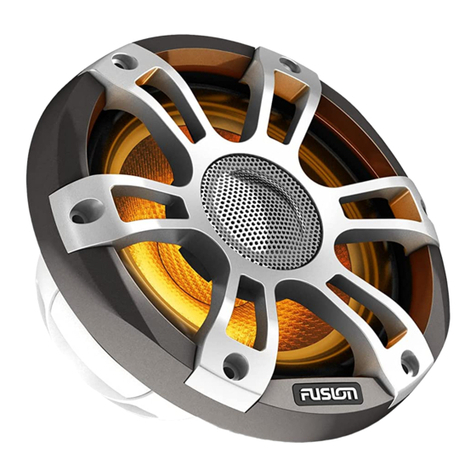
Garmin
Garmin FUSION SIGNATURE Series User manual
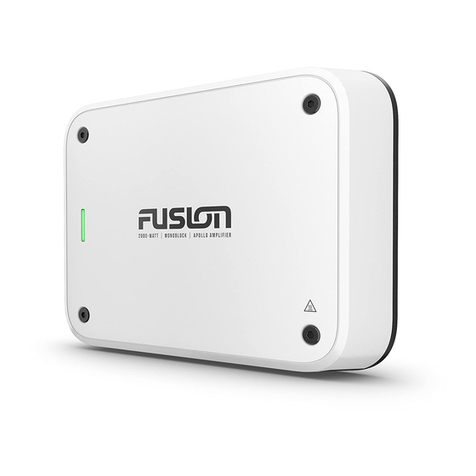
Garmin
Garmin Fusion Apollo MS-AP12000 User manual
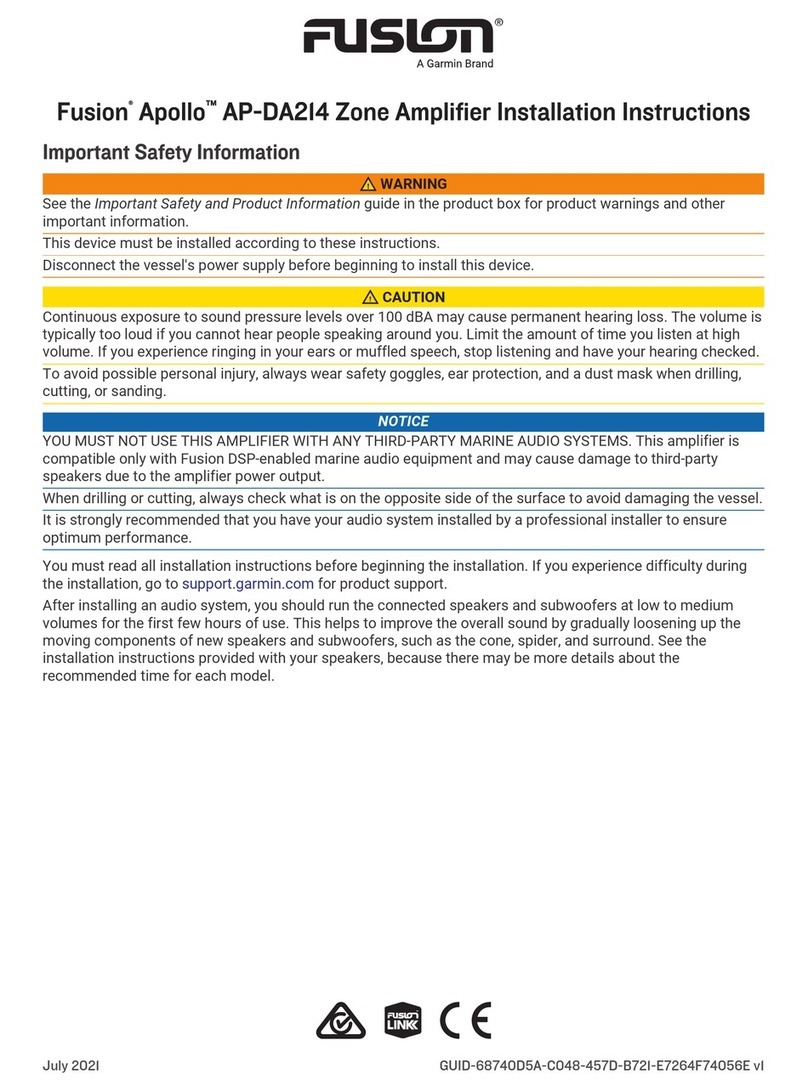
Garmin
Garmin Fusion Apollo AP-DA214 User manual

Garmin
Garmin Fusion Apollo MS-AP12000 User manual

Garmin
Garmin Fusion Apollo MS-AP41200 User manual
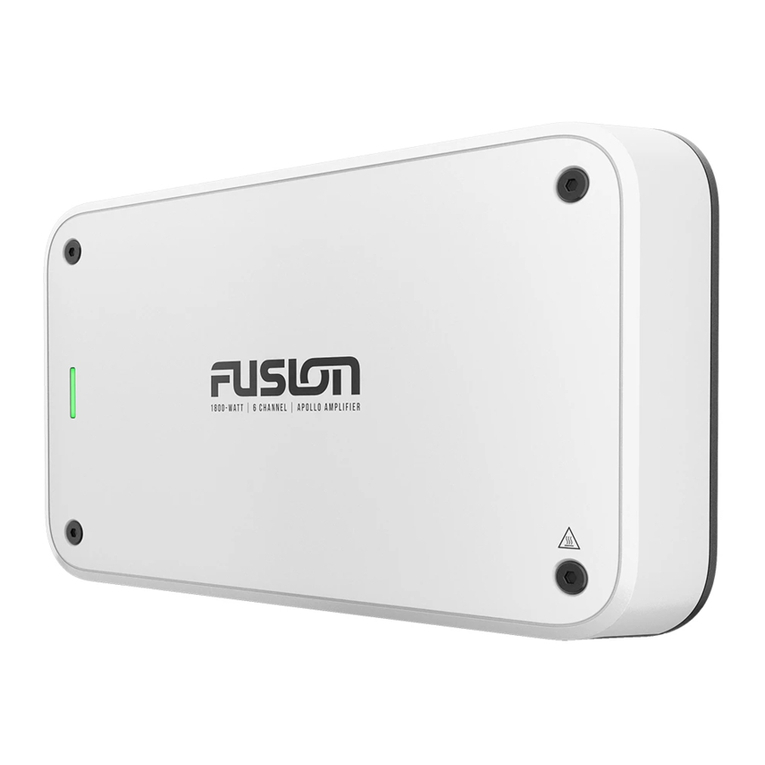
Garmin
Garmin Fusion Apollo Series User manual
